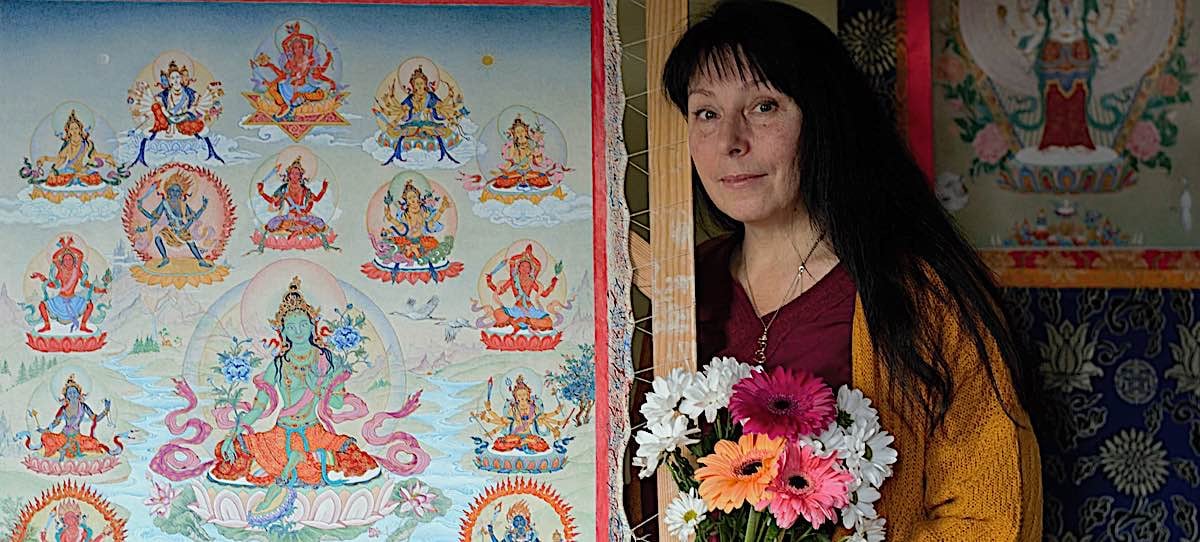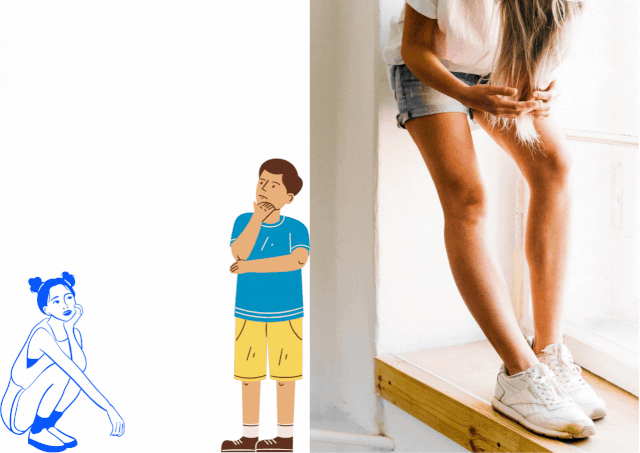Avalokiteshvara’s 108 main forms: one for each mala bead and one for each poison — the many faces of compassion
Why does the compassionate Bodhisattva Avalokiteshvara have specifically 108 forms? Traditionally, one for each bead of a sacred mala (108) — which the main forms of Avalokiteshvara hold in hand — but also represents: the 108 emotions and poisons...
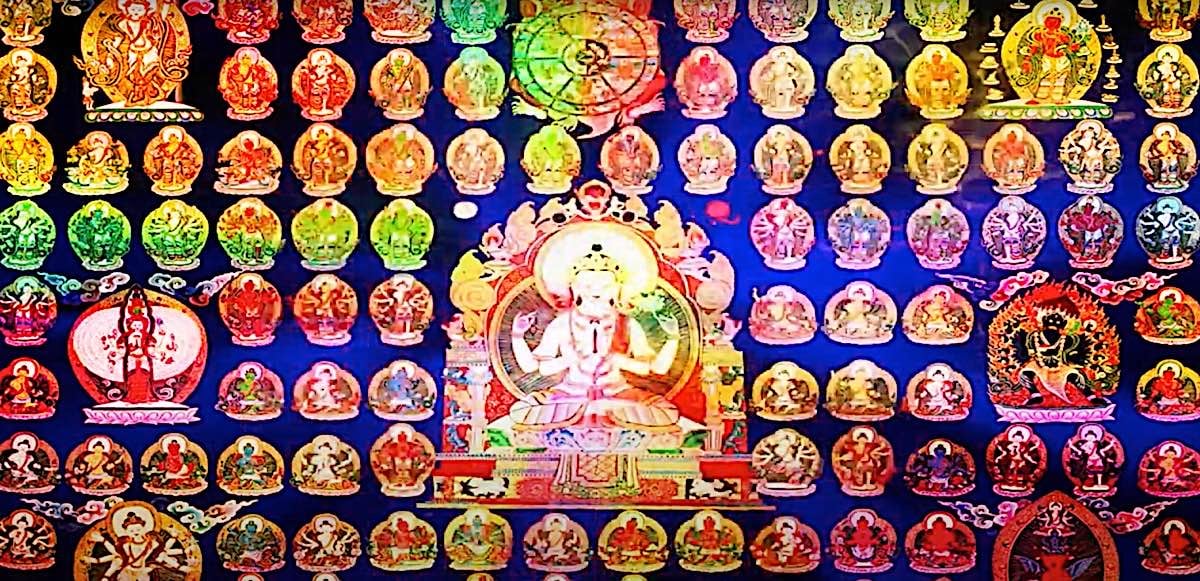
Why does the compassionate Bodhisattva Avalokiteshvara have specifically 108 forms? Traditionally, one for each bead of a sacred mala (108) — which the main forms of Avalokiteshvara hold in hand — but also represents:
the 108 emotions and poisons to be overcome on the path to Enlightenment the 108 energy lines converge to form the heart chakra — important for inner practices (completion stage meditations.) 108 senses representing: the six senses (Smell, Touch, Taste, Sight, Hearing and Consciousness) multiplied by three reflecting painful, pleasant and neutral, then two times for external and internal, and three times for past, present and future. the 108 Tibetan texts most importantly, the 108 methods to overcome the 108 afflictions of sentient beings — one compassionate form of Avalokiteshvara for each. The 108 Forms of Avalokiteshvara (from the video embedded below.)
The 108 Forms of Avalokiteshvara (from the video embedded below.)
Many names of compassion
Avalokiteshvara is a bodhisattva who embodies the compassion of all Buddhas — and not just their compassion, but the activity of compassion that benefits sentient beings.
He is known by many names, including Avalokita, Avalokitesvara, Guanyin, Kannon, and Chenrezig. He also has 108 forms and avatars — one for each bead on a mala string. In Tibetan Buddhism, Avalokiteshvara is the principal Bodhisattva of Compassion. Actually, according to the Lotus Sutra, chapter 25, he has countless forms and can appear in all forms suitable for all sentient life in all of the multiverse and universes.
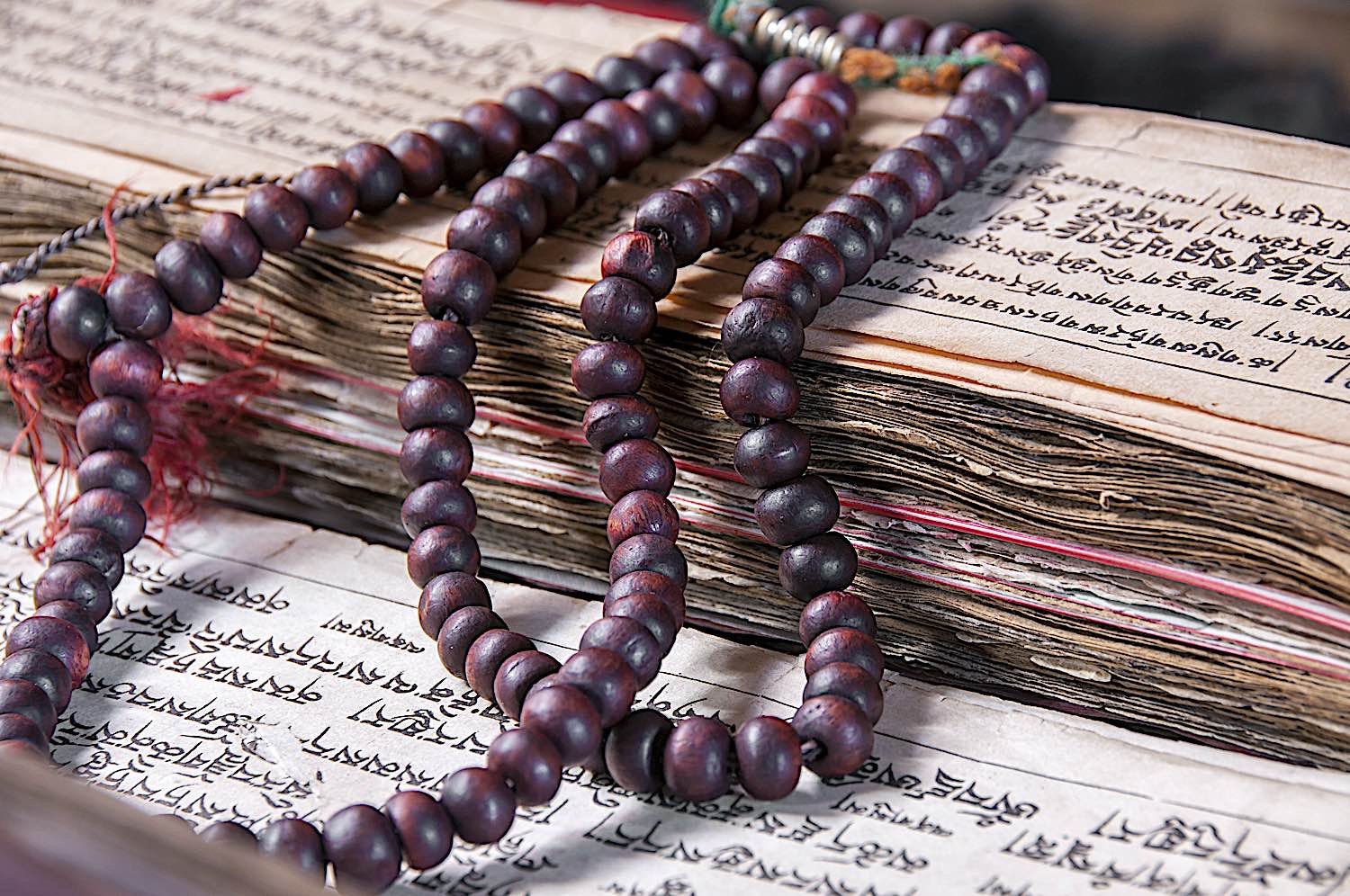 A 108 Bodhi Seed mala, which is the ideal mala for most Buddhist practice, symbolizes many things, including the 108 forms of Avalokiteshvara, the 108 poisons to be overcome in our lives, and so on. Avalokiteshvara forms often have a mala in the right hand.
A 108 Bodhi Seed mala, which is the ideal mala for most Buddhist practice, symbolizes many things, including the 108 forms of Avalokiteshvara, the 108 poisons to be overcome in our lives, and so on. Avalokiteshvara forms often have a mala in the right hand.
Why all these forms? He vowed never to rest until all beings had been liberated from suffering. In order to do this, through his boundless, Enlightened power, he emanates in countless forms. One form even has 1000 arms!
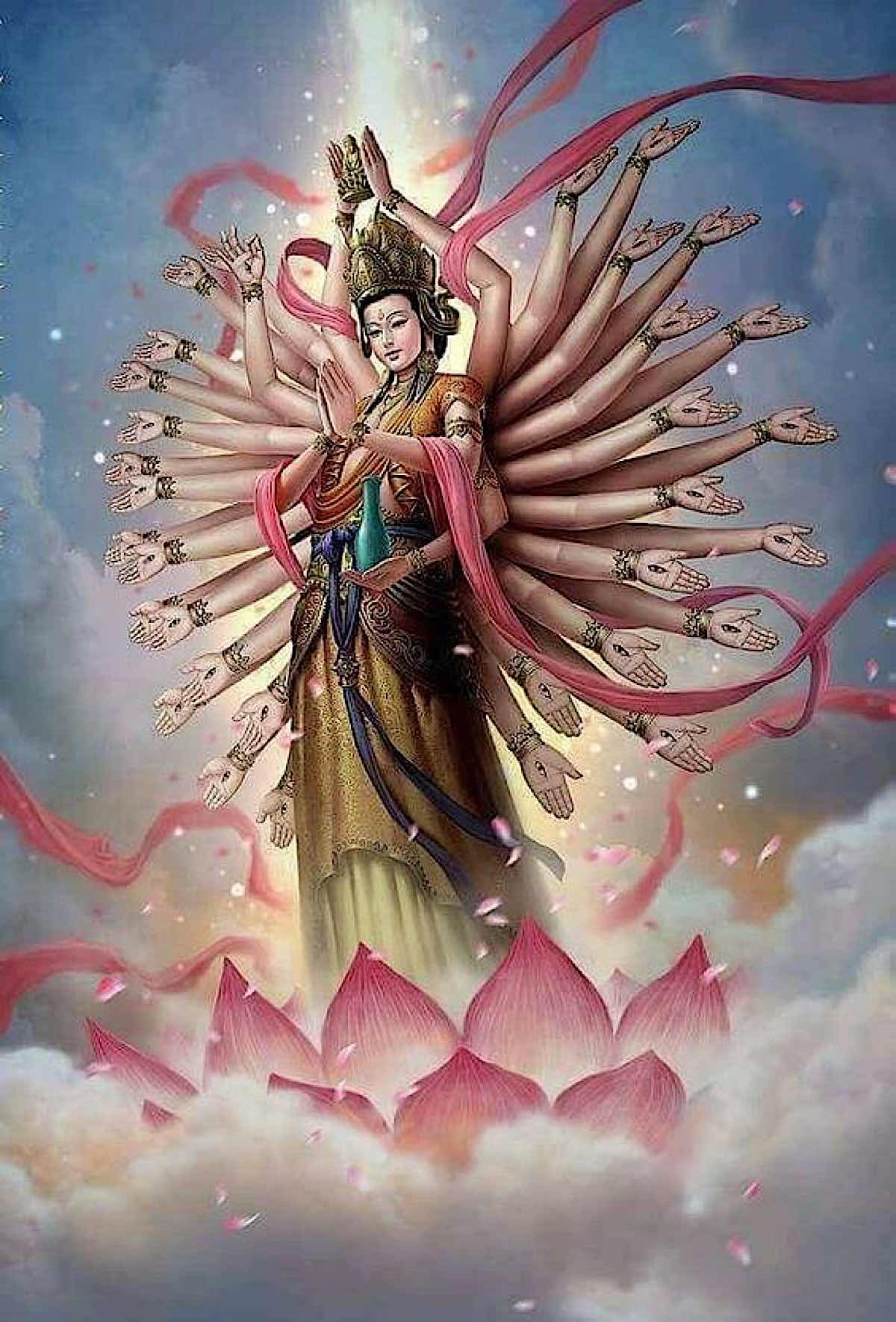 1000-armed Guan shi Yin Avalokteshvara. She manifests with 1000 arms to symbolize her vast and limitless compassionate activities.
1000-armed Guan shi Yin Avalokteshvara. She manifests with 1000 arms to symbolize her vast and limitless compassionate activities.
Why is Avalokiteshvara the most popular of the Bodhisattvas?
He or She is the quintessential “saviour” Bodhisattva, rescuing all beings from harm. This is the purpose behind his many forms.
Robert Thurman explains why Avalokiteshvara Kuan Yin is so popular around the world: “…in a sense, Avalokiteshvara is even more than a buddha. After attaining Buddhahood, he voluntarily returned to the way of a bodhisattva in order to lead all beings to Buddhahood.” [1]
In the Lotus Sutra (Chapter 25), Buddha describes Avalokiteshvara-Guanyin’s many manifestations this way:
“Good man, if there are living beings in the land who need someone in the body of a Buddha in order to be saved, Bodhisattva Perceiver of the World’s Sounds immediately manifests himself in a Buddha body and preaches the Law for them. If they need someone in a pratyekabuddha’s body in order to be saved, immediately he manifests a pratyekabuddha’s body and preaches the Law to them. If the need a voice-hearer to be saved, immediately he becomes a voice-hearer and preaches the Law for them. If they need King Brahma to be saved, immediately he becomes King Brahma and preaches the Law for them. If they need the lord Shakra to be saved, immediately he becomes the lord Shakra and preaches the Law for them. If they need the heavenly being Freedom to be saved, immediately he becomes the heavenly being Freedom and preaches the Law for them. If they need a great general of heaven to be saved, immediately he becomes a great general of heaven and preaches the Law for them. If they need Vaishravana to be saved, immediately he becomes Vaishravana and preaches the Law for them. If they need a petty king to be saved, immediately he becomes a petty king and preaches the law for them.”
For an entire section of 36 features dedicated to the glorious compassionate Buddha Avalokiteshvara, see>> A leaf of a Japanese translation of the Lotus Sutra showing the grand assembly from chapter 1.
A leaf of a Japanese translation of the Lotus Sutra showing the grand assembly from chapter 1.
Avalokiteshvara — Lord of the World
Avalokiteshvara is known as the “Lord of the World” and the “Protector of humanity.” He represents our Buddha nature and our potential for compassion. Avalokiteshvara is a reminder that we are all connected and that we can all strive to attain enlightenment — and that he is not just the Bodhisattva of a few, but of every being. He or She appears — as we’ll see — in all genders, no genders, all forms, all races, all states of being. To an alien on a distant world, he might appear in a form suitable to them. He has peaceful forms, wrathful and monstrous forms, active forms, and can appear as a Deva (god or goddess), human or even animal and bird.
First — He, or She?
In many parts of the world, Avalokiteshvara is symbolized in male form. In other areas, She is a female manifestation — such as Guanyin, Kuanshiyin, Kannon and even Tara. Tara, who in one original sutra arose from the tears of Avalokiteshvara, likewise has 108 forms.
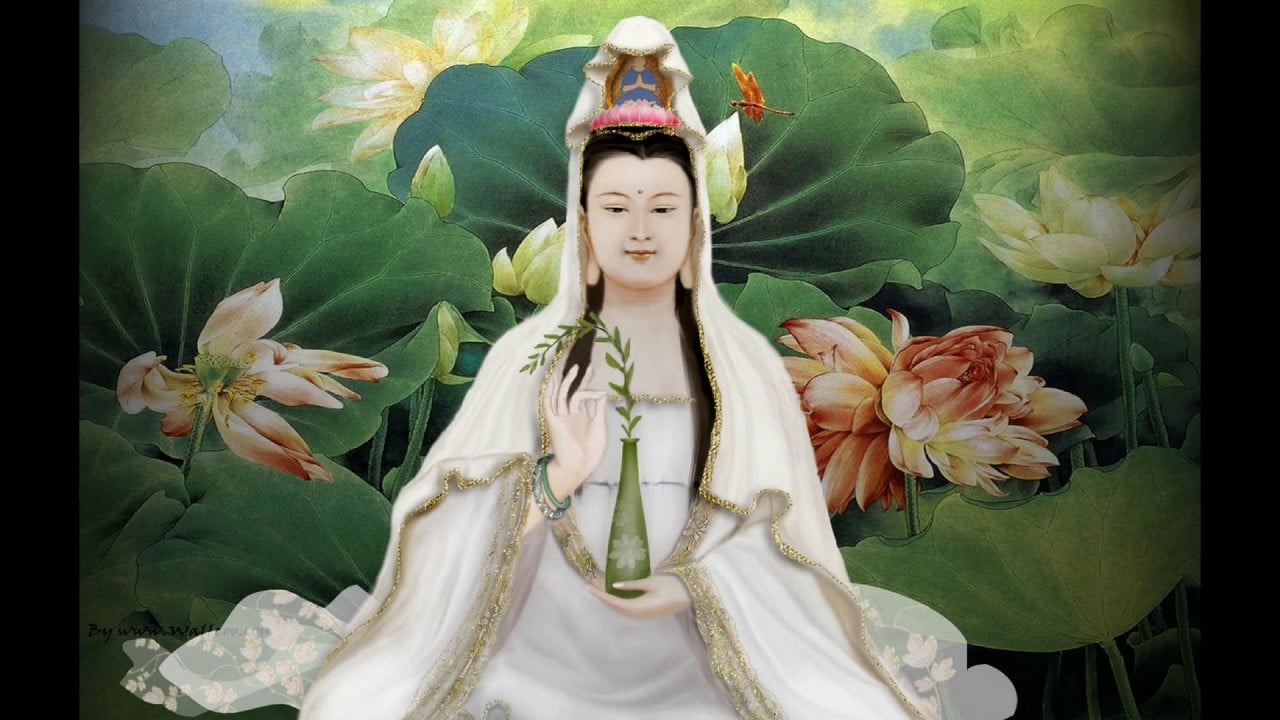 The quality of Compassion is embodied in Guanyin (Kuan Shi Yin, Avalokiteshvara, Chenrezig)
The quality of Compassion is embodied in Guanyin (Kuan Shi Yin, Avalokiteshvara, Chenrezig)
Buddhas transcend sex, of course. When we say Avalokiteshvara is male, or Guanyin is female, this is symbolism. In Vajrayana traditions, compassion and method are symbolized as “male” (and female as “wisdom” — while, for example, in China or Japan, female is more often equated with compassion. The best way to understand this is that Buddha’s compassion can manifest in any form — and not just male or female, but even as devas, animals and demonic forms. Whatever form suits the compassionate activity is manifested.
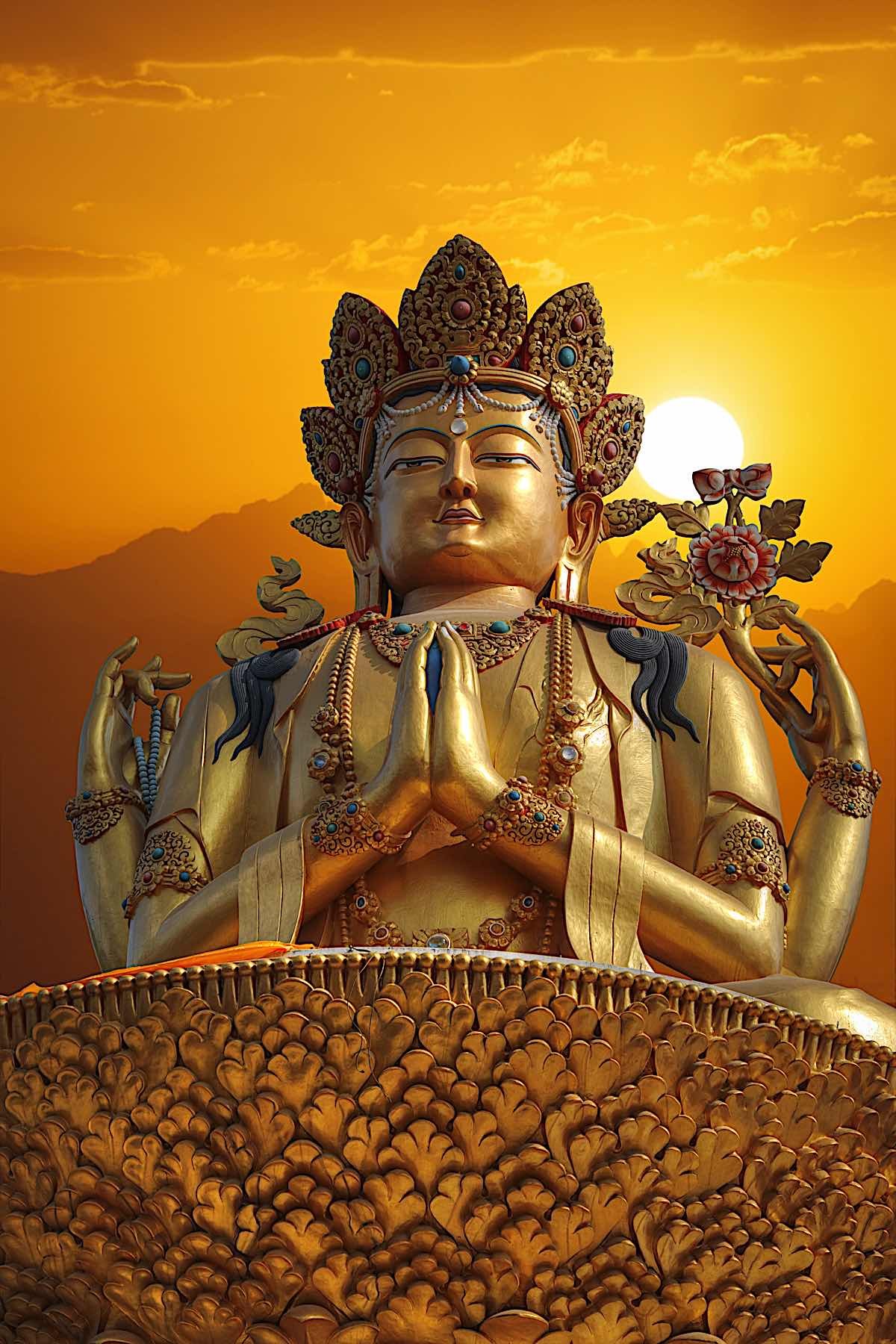 Four-armed Avalokiteshvara. The kindness of his face and his four arms — ready to reach out with compassion and love to protect and nurture — are the ultimate “Bodhisattva” hero ideal. In one of his four hands is the crystal mala of 108, representing his 108 forms and the 108 poisons and emotions to be overcome.
Four-armed Avalokiteshvara. The kindness of his face and his four arms — ready to reach out with compassion and love to protect and nurture — are the ultimate “Bodhisattva” hero ideal. In one of his four hands is the crystal mala of 108, representing his 108 forms and the 108 poisons and emotions to be overcome.
What are some of the many forms and avatars of Avalokiteshvara?
Some of the most well-known forms and avatars include:
• Thousand Armed Avalokiteshvara, who is often depicted in statues with 1000 arms to symbolize his compassionate activity for all beings throughout the universe.
• White-robed Guanyin, who is known as the savior of women and children.
• Mahakala, who protects against negative energies.
• Horse-crowned Hayagriva — the ferocious Heruka emanation of Chenrezig, and many others.
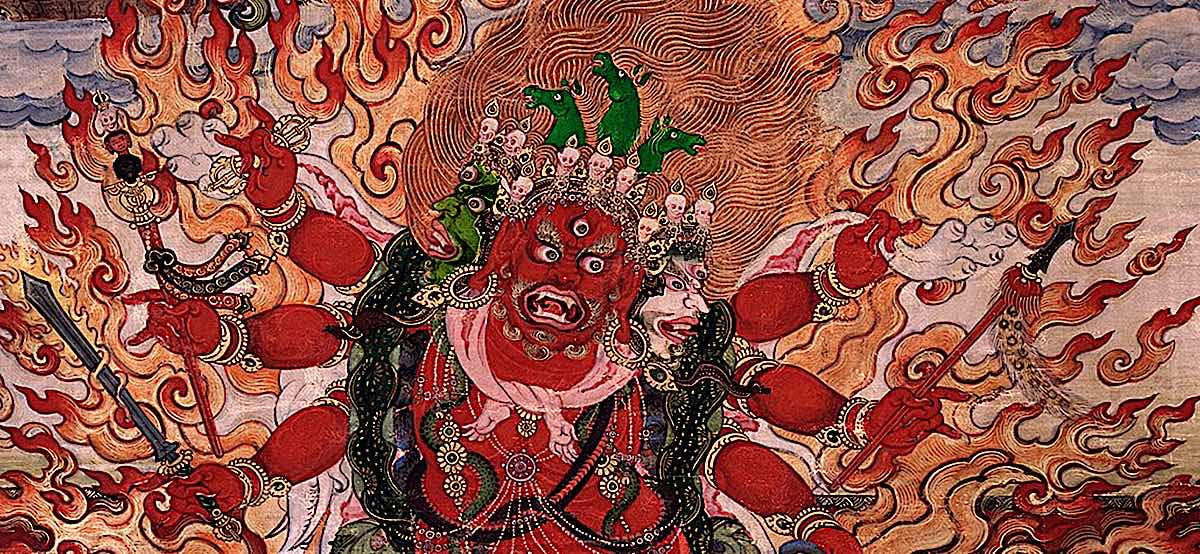 Hayagriva Sandrup closeup with three green horse heads and three faces red centre, green right and white left with six arms, supreme Heruka of the Amitabha Family — and the most Heruka wrathful manifestation of Avalokiteshvara. For a full feature on Hayagriva Sangdrup, see>>
Hayagriva Sandrup closeup with three green horse heads and three faces red centre, green right and white left with six arms, supreme Heruka of the Amitabha Family — and the most Heruka wrathful manifestation of Avalokiteshvara. For a full feature on Hayagriva Sangdrup, see>>
Each of these manifestations embodies a particular compassionate activity for all beings
Avalokiteshvara is a bodhisattva who represents compassion in Mahayana Buddhism. In Chinese culture, Avalokiteshvara is known as Guanyin, and she is one of the most popular deities in East Asia. Avalokiteshvara is often depicted as a young woman with a thousand arms and eyes, symbolizing her ability to hear the cries of all beings and help them in their time of need. Or, as a 1000-armed male Buddha with many heads.
Avalokiteshvara is also sometimes shown holding a lotus flower, which represents her purity and compassion. As a bodhisattva, Avalokiteshvara has vowed to remain in the world until all beings have attained enlightenment. Therefore, she represents the ideal of selfless compassion, and her worshipers strive to emulate her compassionate example.
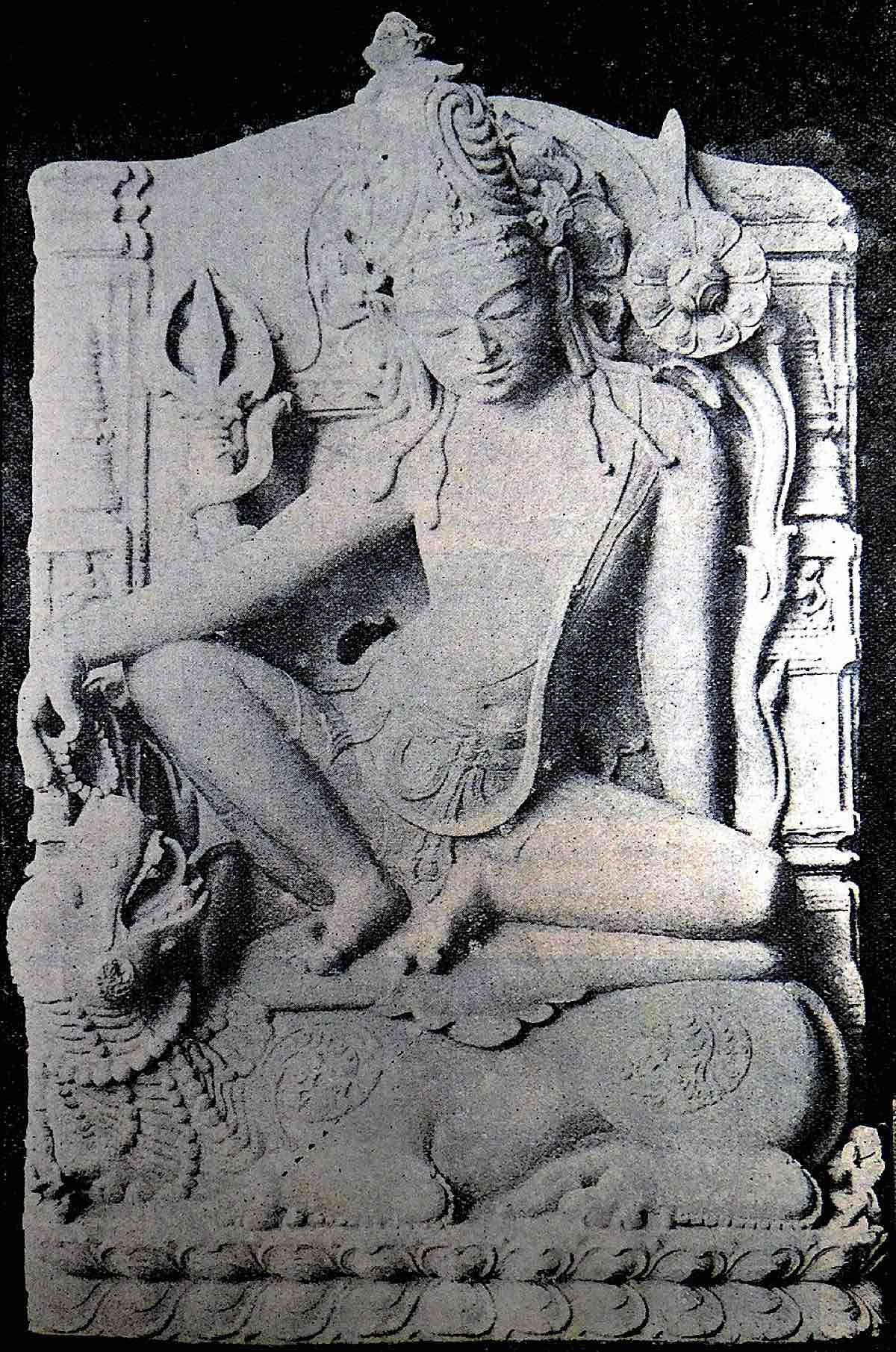
Six Principle Forms in Vajrayana
According to Himalayan Art, the “Six Principal Iconographic Forms of Lokesvara, are:
1. Amoghapasha
2. Chaturbhuja
3. Eleven Faces
4. Jinasagara
5. Khasarpana
6. Simhanada”
Video: 108 forms of Avalokiteshvara with Om Mani Padme Hum mantra:
The 108 Forms and more
Although the Sutras list the 108 names and forms, for clarity there are countless more. Here, we only list the 108 names [2] :
Mojaghanjabala Lokeshvara Pupala Lokeshvara Unnauti Lokeshvara Vrsnacana Lokeshvara Brahmadanda Lokeshvara Acata Lokeshvara Mahavajrasattva Lokeshvara Visvahana Lokeshvara Sakyabuddha Lokeshvara Santasi Lokeshvara Yamadanda Lokeshvara Vajrosnisa Lokeshvara Vajrahuntika Lokeshvara Jnanadhatu Lokeshvara Karandavyuha Lokeshvara Sarvanivaranaviskambhi Lokeshvara Sarvasokatamonirghata Lokeshvara Pratibhanakakuta Lokeshvara Amrtaprabha Lokeshvara Jaliniprabha Lokeshvara Candraprabha Lokeshvara Avalokita Lokeshvara Vajragarbha Lokeshvara Sagaramati Lokeshvara Ratnapani Lokeshvara Gaganaganja Lokeshvara Akasagarbha Lokeshvara Ksitigarbha Lokeshvara Aksayamati Lokeshvara Srstikanta Lokeshvara Samantabhadra Lokeshvara Mahasahastabhuja Lokeshvara Maharatnakirti Lokeshvara Mahasankhanatha Lokeshvara Mahasahasrasuryya Lokeshvara Maharatnakula Lokeshvara Mahapatala Lokeshvara Mahamanjudatta Lokeshvara Mahacandrabimba Lokeshvara Mahasuryyabimba Lokeshvara Maha-Abhayaphalada Lokeshvara Maha-Abhayakari Lokeshvara Mahamanjubhuta Lokeshvara Mahavisvasuddha Lokeshvara Mahavajradhatu Lokeshvara Mahavajradhrk Lokeshvara Mahavajrapani Lokeshvara Mahavajranatha Lokeshvara Amoghapasa Lokeshvara Devadevata Lokeshvara PindapatraLokeshvara Sarthavaha Lokeshvara Ratnadala Lokeshvara VisnupSni Lokeshvara Kamalacandra Lokeshvara Vajrakhanda Lokeshvara Acalaketu Lokeshvara Sirisara Lokeshvara Dharmacakra Lokeshvara Harivahana Lokeshvara Sarasiri Lokeshvara Harihara Lokeshvara Simhanada Lokeshvara Visvavajra Lokeshvara Amitabha Lokeshvara Vrjrasattvadhatu Lokeshvara VisvabhutaLokeshvara Dharmadhatu Lokeshvara Vajradhatu Lokeshvara Sakyabuddha Lokeshvara Cittadhatu Lokeshvara Cintamani Lokeshvara Santamaria Lokeshvara Manjunatha Lokeshvara Isnucakra Lokeshvara Krtanjali Lokeshvara Visnukanta Lokeshvara VajrasrstaLokeshvara Sankhanatha Lokeshvara Vidyapati Lokeshvara Padmapani Lokeshvara Vajrapani Lokeshvara Mahasthamaprapta Lokeshvara Vajranatha Lokeshvara Srimadaryavalokiteshvara Nityanatha Lokeshvara Sukhavati Lokeshvara Vajradharma Lotkesvara Vasyadhikara Lokeshvara Khasarpana Lokeshvara Simhanatha Lokeshvara Trailokyasandarsana Lokeshvara Raktaryavalokitesvara Nilakantha Lokeshvara Sugati-Sandarsana Lokeshvara Mayajalakrama Krodha Lokeshvara Preta-Santarpita Lokeshvara Jatamukuta Lokeshvara Varadayaka Lokeshvara Kamandalu Lokeshvara Manipadma Lokeshvara Pitapatta Lokeshvara Anandadi Lokeshvara Sadaksari Lokeshvara Mayajalakrama Lokeshvara Harihariharivahana Lokeshvara Halahala Lokeshvara Hayagriva LokeshvaraMantras
Each of the forms has their own attributes, visualization, symbolism and mantras, especially major Yidams such as Hayagriva. Generally, though, the Mani Mantra is the best way to honor any form of compassion:
Om Mani Padme Hum
(Sanskrit)
Om Mani Peme Hung
(Tibetan)
For an entire section of 36 features dedicated to the glorious compassionate Buddha Avalokiteshvara, see>>For more on the symbolism and attributes of the 108 forms, refer to the Wisdom Library’s profile of the book:
The Indian Buddhist Iconography by Benoytosh Bhattachacharyya | 1958 | 51,392 words | ISBN-10: 8173053138 | ISBN-13: 9788173053139 found here>>
NOTES
[1] “Avalokiteshvara in Tibet”, Tricycle
[2] 108 Names of Avalokiteshvara>> https://mandalas.life/2018/108-names-of-avalokiteshvara/

 AbJimroe
AbJimroe 







